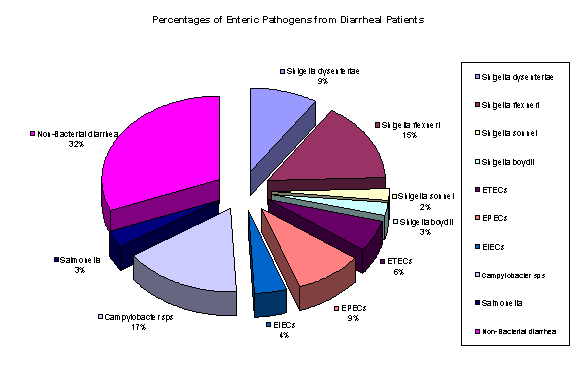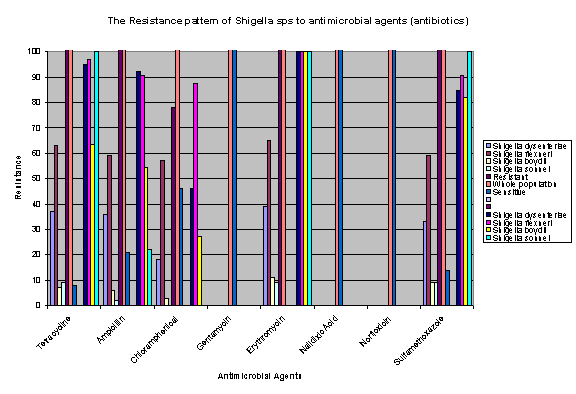Principal Investigators:
Willie K. Sang Senior Research Officer
Jon Davis
USAMRU-Kenya
Staff:
Michael Auko
USAMRU-Kenya
Valarie Oundo
USAMRU-Kenya
Denis Odera
KEMRI
Collaborators:
Anik MSF France
Upendo
Mathare Clinic Nairobi
Background:
Diarrhoeal diseases are major causes of morbidity and mortality among children indeveloping countries. Although entero-haemorragic E. coli seems to exist world wide,isolated reports from African countries are few, and particularly in Kenya where only one case of 0157:H7 has been reported (Sang et.al). There is no well-establishedlaboratory-based survellance for monitoring drug resistance of enteric pathogens or new emerging enterics.
Besides the entero-haemorragic E. coli, several other enteric pathogens were isolated such as shigellae, salmonellae, enterotoxigenic E. coli, enteroinvasive E .coli and enteropathogenic E. coli. The overall objective is to investigate the extent of EHEC and to establish the proportion and patterns of drug-resistance of enteric. The data obtained from this study will be used for the surveillance and monitoring of drug resistance enteric pathogens and that of emerging enteric pathogens.
This data will also be used for intervention and management of diarrhoeal disease countrywide and particularly in cases of outbreaks. The data would also provide a suitable place for enteric vaccine trials.
METHODS:
Sample
size:
The epidemiological data
obtained from February 2000 to October 2001 from the slums of Mathare in the
Nairobi suburbs has portrayed a different picture from that obtained from rural
population. A total of 424 patients
who met the requirements for diarrhoeal case definition were enrolled in the
study.
Case
Definition:
Subjects from all ages raging from 3 months to 70 years of age were enrolled in the study if three or more loose or unformed stools were passed in a day and the subject complained of stomachache or diarrhea.
Epidemiological
data collected:
A consent form was provided to participants before the standard questionnaire forms were filled. Participation was entirely voluntary. Name, age, sex, occupation, location,
temperature, pulse, respiration, number of days with diarrhea, maximum number of stools per day, if any antibiotics were given or previous treatment with antibiotics, level dehydration, and the onset of illness were recorded.
Microbiology:
The stool specimens were collected at Mathare Clinic, placed in Cary-Blair media and transported to the lab within a day. The samples were plated onto XLD, MaCconkey, Sorbitol-MaCconkey, and Campylobacter free media. All were incubated at 37 degrees Celsius for 18 hours except for the Campylobacter, which were incubated at 42 degrees Celsius for 48 hours. Identification of the isolates were done using the standard biochemical media and characterized by sereotyping with the commercial anti-sera, Denka Seiken Tokyo, Japan.
Antibiotic susceptibility testing was performed using the Kirby-Bauer disc diffusionmethod according to NCCLS guidelines. PCR for virulence strains was performed using specific primers for gene amplification of the toxins, Stx1, Stx2, Vte, LTs, and eae gene for intimin using the method of Paas et.al. Hep-2 cell adherence assays were performed according to the method of Cravioto et.al. and titres of positive strains were performed.
Analysis
and Reporting:
Laboratory reports were sent to the doctor in charge of the clinic. We retained the results and analysis in our computer database.
Progress:
A diarrhoeal study, at Mathare Upendo Clinic, in the slums of Nairobi, started in February 2000 and ended in October 2001. A total of 424 patients, who presented with diarrhea were attended to.
The overall isolation rates for diarrhoeal pathogens in stools were 29% for Shigella species, 19% pathogenic E. coli (ETECs, EPECs and EIECs), 17% Campylobacter species and 3% Salmonella species. The isolation rate for Shigellae from Mathare was the same as that of Kibera. The resistant patterns from the two slums were relatively the same for all the enterics isolated. Salmonella isolates had the same resistant pattern, as did Shigella. However, a different study conducted in a rural Masai population had a different picture in that the resistance rates were much lower as compared to that of the urban population. Also, ETECs were more predominant in the rural population than the urban population. The high isolation rate of Campylobacter in the Mathare study opens a new chapter for more investigations, because Campylobacter has not been at the center of interest in most diarrhoeal studies in Kenya.
Considering seasonal variations, diarrhoeal cases almost double during the rainy seasons, perhaps because the pit latrines in the slums become full and overflow with fecal material which makes it more likely to come in contact with the general population. The fecal contamination rates in these slums are high and, therefore, outbreaks of diarrhoeal diseases are possible.
Conclusion:
This results from this study has shown that Campylobacter species play a major role in diarrhoeal illness in the slum population. Shigellosis had already been noted as one ofthe major causes of diarrhea in urban populations. More studies are needed to confirm the role of Campylobacter in diarrhoeal illnesses in Kenya. The data obtained from this study has revealed that the resistance of enteric pathogens to antibiotic, especially those recommended for treatment, are different from one region to another. Regional studies are needed to point out the resistance patterns to antibiotics.


